The joy of summer green and beauty of cool white are accurate descriptors of the Yarrow, Achillea millefolium, in my garden. Gifted to me as a passalong plant some 20 odd years ago, it is a plant that is lovely to view and easy to grow.
A member of the Asteraceae (Aster) family, common Yarrow grows throughout a large area of continental North America. According to the Lady Bird Johnson Wildflower Center (LBJWC) plant data base, the plant is classified as both a single species with varieties and as multiple distinct species. 
My guess is that mine is the true native variety, considering how long I’ve had the plant (hybrids and cultivars are now more readily available than when I was given my Yarrow starts) and that the blooms are a natural snowy white, rather than hybrid pink or yellow. Yarrow’s fine foliage is 5-6 inches tall and acts as a lacy ground cover for most of the year. In early spring, the graceful low-growing foliage grows anew and also sends bloom stalks upward to meet the spring sky. In time, buds appear at the terminal ends of multiple branches.
Depending upon sun amounts received, Yarrow bloom stalks can reach upwards to three feet. Mine all grow with some shade, which is ideal for Yarrow. While Yarrow is a great plant for shade or part shade, in my experience, deep shade will render the plant a full-time, evergreen ground cover, but it abandons all attempts at blooming.
But with some sun, the garden benefits from both beautiful foliage and flowers.
By May and throughout June, the disk flowers open for pollinator business and gardener admiration.
Most of the pollinators I see on Yarrow are of a diminutive sort; these include many types of flies, tiny native bees, and the smaller butterflies.
This Horsefly-like Carpenter bee is one of the larger pollinators to visit my Yarrow blooms.
I grow Yarrow in several areas of my garden and it’s complementary to other members of a perennial garden.
Additionally, Yarrow adds a prairie quality to the summer garden. The prime bloom time lasts about 6-8 weeks, but even when the flowers fade, Yarrow remains handsome.
Into July, a toasty quality appears on Yarrow as the pure white flowers go to seed. As summer settles in with its heat and glaring sun, the flowers decline, seeds develops and Yarrow’s pure white tops turn tan and toasty.
The white Yarrow blooms are hard to improve upon, but as the plant undergoes its seasonal evolution, I don’t mind the transition from blooms to seed. It’s a gradual transition and the plant remains attractive for most of summer.
I’ve seen House Finches and Lesser Goldfinches nibbling at the Yarrow seeds, so along with it acting as a good pollinator plant, other wildlife benefit from this perennial as its growing season advances.
Yarrow’s flower-to-seed heads beauty doesn’t last forever, though. Typically, by the time the flowers are long done and the seed heads are crumbling, the bloom stalks are also bent with age and environmental impacts. After all, they’ve held aloft sweet blooms and nutty seeds for many to enjoy through spring thunder and wind storms and searing summer sun. Bottom line: Yarrow is messy by late summer.
Sometimes, parts of the foliage turns brown in sympathy with the beige seed heads.
Once the bloom stalks have flopped for good, I cut them back. There’s no real art or skill with this pruning, it’s just about cutting the now-brown stalks at or near the ground, which usually reveals new ground cover growth settling in place for the coming seasons: autumn, winter, spring.
In the above photo, the remains of pruned stalks lie disguarded outside of the garden’s limestone border; you can see new Yarrow foliage emerged on the other side of the limestone. This foliage will be the basis of the ground cover which will flush out during autumn and remain evergreen in winter.
In especially dry summers and/or if I haven’t irrigated, the new ground cover foliage endures a breaking-in period where it’s sparse and ratty looking; Yarrow down-time usually occurs in August. Fortunately, the ugly duckling phase doesn’t last long, because the foliage quickly greens up and fills in with help from the shorter days and regular rainfall that September normally brings.
While Yarrow flowers produce seeds (those finches are eating something!), the only spread I’ve observed is with the roots of established plants. In this shot, the foliage has crept out of the border of the garden and into a walkway. I’m tolerant of this creeping action–to a point. When I’ve had enough of Yarrow’s teen-like testing of boundaries, I simply dig out the offenders and toss them into the compost bin or give to another gardener. With healthy attached roots and a smidge of extra watering, Yarrow transplants easily.
By autumn, brilliant green, ferny foliage returns and the groundcover is set for the upcoming cool seasons.
I’ve experienced no insect or disease problems with Yarrow and it’s a drought tolerant plant. Another plus with planting Yarrow is that it is deer resistant. Its foliage and flowers are fragrant and has been used for medicinal purposes. I’m not big on cut flowers, but Yarrow is a nice addition to a vase.
Because it’s somewhat statuesque from April to August and low-to-the ground for the rest of the year, care should be exercised when considering placement of Yarrow: it works in the back of a bed during its peak blooming time, but will be unseen for the remainder of the year. My solution has been to plant all my Yarrow along pathways and pair it with similar sized plants.
Whether you purchase Yarrow or it’s given to you as a passalong plant, treasure it! Yarrow is easy to grow and lovely to look at.
In Spring:
Summer:

My sweet old dog, Asher, enjoying the garden one afternoon, several years ago. Asher died late last summer.
Late Summer:
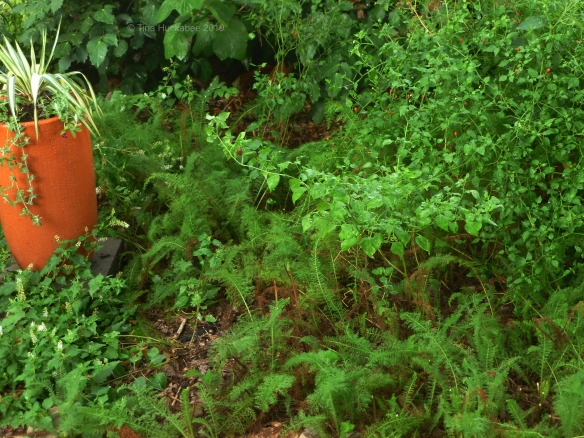
Yarrow in its ground cover mode planted with Chili pequin (top right) and a container plant (left).
Autumn and Winter:
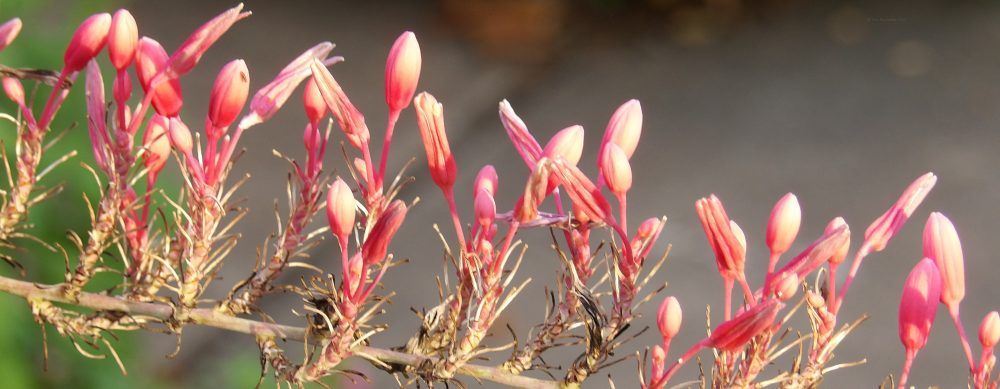



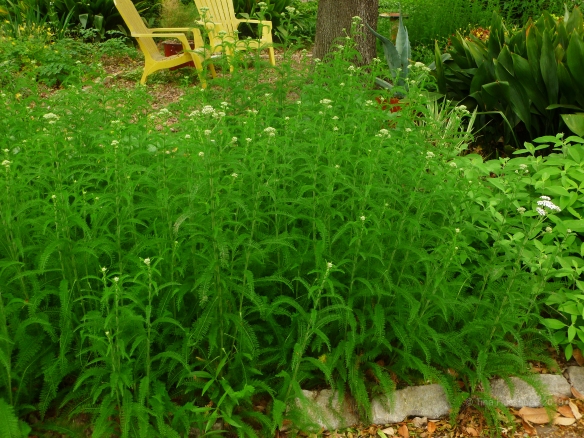


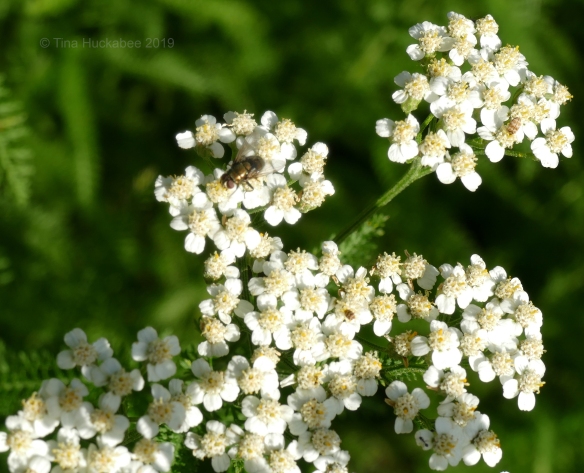

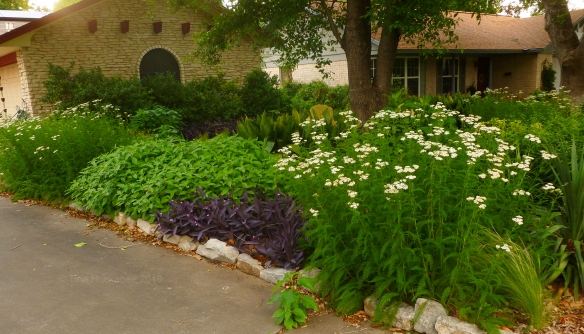




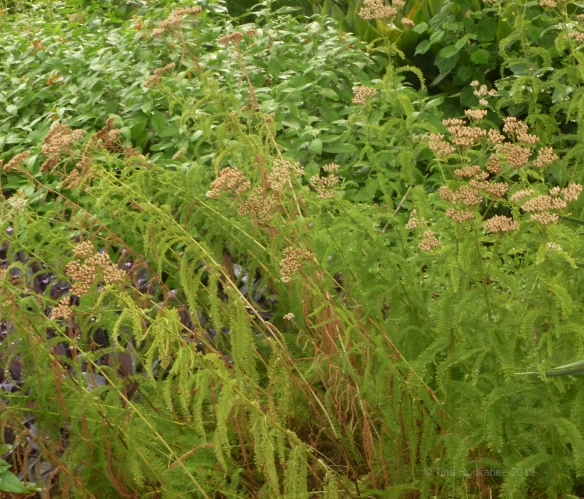

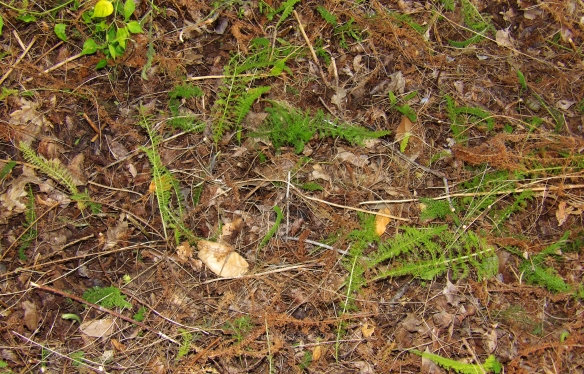




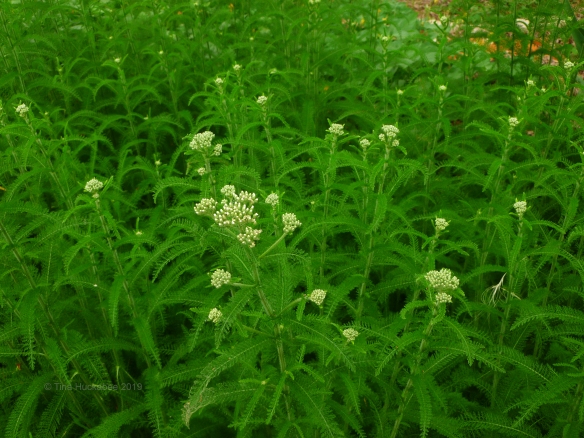

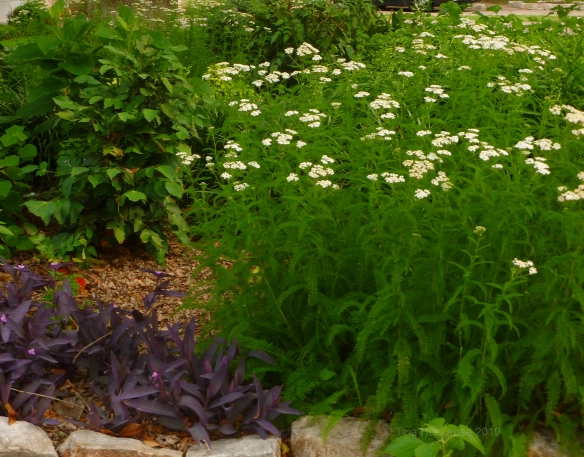



Beautiful!
LikeLike
It is a beauty!
LikeLiked by 1 person
I’ve wondered over the years whether Peter Yarrow (of Peter, Paul and Mary) knows that his last name is this plant.
LikeLike
You and me, both!
LikeLike
You have had really good luck with your yarrow. I have planted it in various parts of my yard and it always disappears.
LikeLike
I wonder why? Interestingly, about 3 years ago the oldest group of yarrow was declining. I watched it for two years, then decided to pull up all that remained and replant. That seem to do the trick, so I’ve “refreshed” the other 3 areas in my garden where it grows. I’m wondering if (roughly) once per decade, it needs to be separated and replanted. That doesn’t answer your issue, of course.
LikeLiked by 2 people
Maybe because it is wetter here.
LikeLiked by 1 person
I have this yarrow in my front garden and am growing it from seed in pots to add to my work-in-progress side slope meadow this fall. I love how tough it is plus, it’s a beauty. I love the long shot pic of your front garden! Beautiful!!
LikeLike
Thanks! Interesting–I’ve never had luck with germinating the seeds. It’s fine, yarrow transplants well with root, but still.
LikeLike
I threw the seed on the surface of the soil in some pots, watered them and they’re growing. :o)
LikeLike
That certainly seems easy enough. Good luck–it’ll be beautiful on that slope.
LikeLike
Nice to see your garden from a broader perspective (that single photo) — it looks so welcoming!
LikeLike
Thanks, Hollis. I do hope that it’s welcoming.
LikeLike
A beautiful summer bloomer–interesting to see the different stages. Thanks for sharing!
LikeLiked by 1 person
You’re welcome, Beth and it is a lovely plant.
LikeLike
And here we are — back in business, with a fresh, new internet connection. Three days was long enough, believe me, but the good (and unexpected) news is that my upload and download speeds have increased noticeably. It doesn’t really make that much difference for me, but if I were a gamer, I’d be in heaven.
Your yarrow is heavenly, that’s for sure. Its blooms are so pretty, but the fading, crispy browns remind me of the attractiveness of prairie plantain once it begins to turn. I’m fond of seedheads anyway, so I’d see those lingering yarrows as a great plus — they certainly do complement the other plantings in the garden.
LikeLiked by 1 person
Glad you’re able to re-engage with the world, though perhaps you might not want to do that?
Yarrow is a great plant, though beginning to look a bit peaky now. I like seed heads too and leave them on spent blooms as long as I can. The downside is that, well, seeds drop and then germinate. What to do with all those seedlings??
LikeLiked by 2 people
I’m a bit spoiled for wild yarrow by the cultivars and their rich colors. Good post, though, I like how you show the yarrow in each season.
LikeLiked by 1 person
I still favor the white-I love white flowers in my garden. But I appreciate the draw to the colorful hybrids/cultivars.
LikeLiked by 2 people
Curious that it hasn’t spread from seed. I’ve given up hope on sowing yarrow after 4+ attempts with seed packets over 8+ years of trials. Perhaps the seeds need a harsher winter than we offer?
LikeLiked by 1 person
Agreed. Casa mariposa (aka, Tammy) gardens in Virginia and is growing some by seed. You might be right about winter, because mine have never spread by seed–only root. If you ever want some starts by root, ping me–we can coordinate a hand off either in late fall or spring. Even winter isn’t a bad time to transplant, but you’d have to keep an eye on them in all your spare time. 🙂
LikeLike
I’d love some! I’m not sure exactly what this “spare” is of which you speak, but I’m trying to learn more about it 😉
LikeLiked by 1 person
It does not look familiar. I would also guess that it is closer to a simple species than to a garden variety, but I really do not know, and have not experienced more than just a few. I have only two main species here, and the Achillea millefolium does not look like yours. It is lower and more compact. I do happen to like the colors though, because they do not look so weirdly synthetic like so many varieties of other flowers look.
LikeLiked by 1 person
Apparently, there are all sorts of varieties and cross-varieties that fit under the title Achillea millefolium. That just makes it all so interesting!
LikeLiked by 2 people
and confusing
LikeLike
Lol!
LikeLiked by 1 person
Pingback: May Flowers | My Gardener Says…
Wow, I just discovered your blog. And that was an audible *wow!* by the way. I was blown away by your documenting of the seasonal changes. Thank you so much, it helps me immensely visualize and plan my own native garden. Dream blog!!
LikeLike
Awe, you’re so kind, Barbara! I’m glad the blog has been helpful to you, afterall, it’s what we gardeners do, isn’t it? Share! Thanks for reading!
LikeLike
Hi, I also just came upon your blog. I am hoping you are available to educate me on Yarrow. I planted some in a raised bed last year in anticipation of growing more of it to spread around the rest of the garden. I didn’t and still don’t know a lot about it. So here in NW Montana at the beginning of May the Yarrow is greening up, spread out from last summer’s planting. We have projected lows at or near freezing for the next week. It could be another month or so with those low temps coming and going. I only now have been reading that it is best to transplant Yarrow when it is dormant. With the greening it appears I missed that window. I am wondering if there is leeway to transplant now? What do you recommend ? Thank you for any help.
LikeLike
Hi Ana! I garden in Central Texas, a very different climate and soil than yours. My experience with yarrow is that it’s perfectly fine in freezes, at least to the high teens/20s. I’d suggest you contact your County Extension agent’s office or a local gardening group and find out about yarrow in your area. I know that yarrow is native to a wide area of North America and that it’s probably fine in your area, but again, your conditions are very different from mine. Good luck with it; my hunch is that it’ll be just fine.
LikeLike